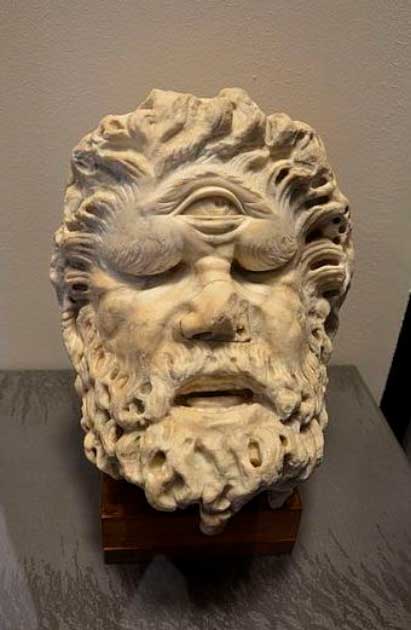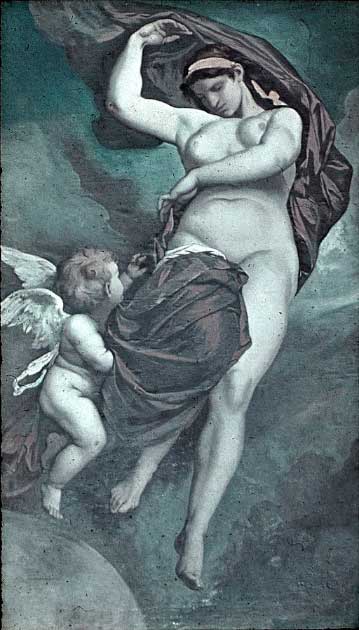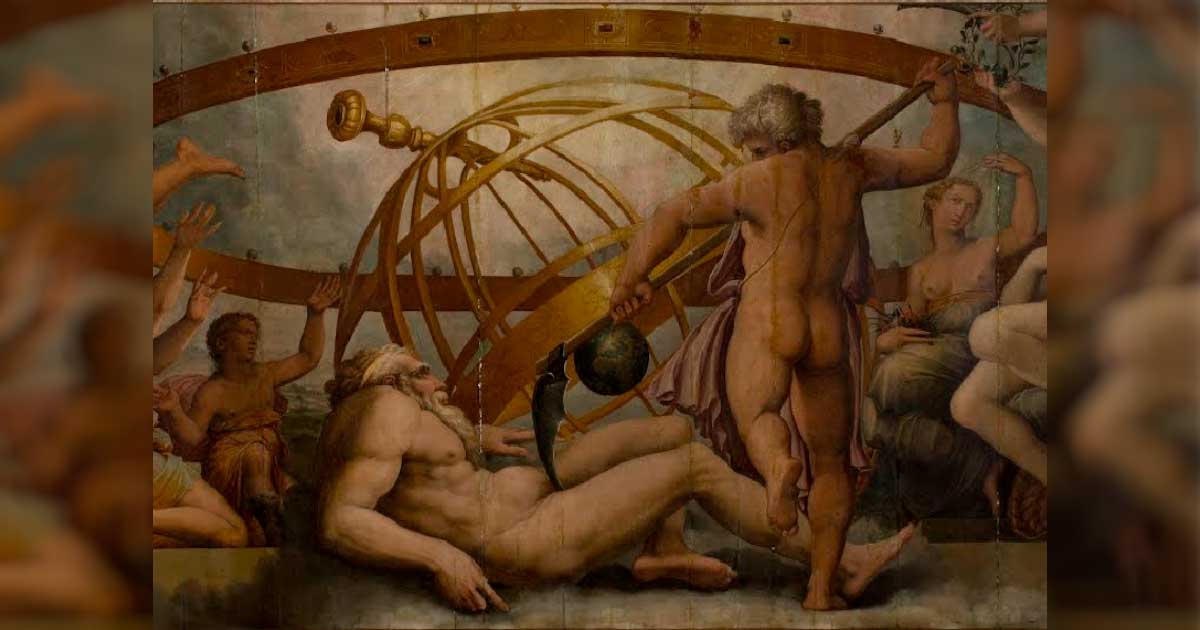Uranus: Greek God of the Sky and Heavens, Castrated by His Own Son!
Uranus was the Greek primordial god of the sky and heavens from whom all other gods and divine creatures later descended. Whilst he was sometimes seen as the ruler of the sky and heavens, he was also the personification of them. In the ancient Greek religion he was not worshipped as a god, but rather as a force of nature, and it wasn’t until Roman times that he was depicted in artwork.
It is thought that the Greek root of the name Uranus is Ouranos which means sky or heaven. In Latin the word “uranus” also translates to sky, but it seems to have been attributed to the Greek god much later.
Uranus in Mythology
The tale of Uranus begins with the beginning of time. According to Greek mythology, the universe began with Khaos (chaos or the chasm) who is said to represent air. After Khaos came Gaia, the Earth. After Earth came Tartarus (Hell), Eros (Love), Erebos (darkness) and Nyx (black night).
“Verily at the first Chaos came to be, but next wide-bosomed Earth, the ever-sure foundations of all the deathless ones who hold the peaks of snowy Olympus, and dim Tartarus in the depth of the wide-pathed Earth, and Eros (Love), fairest among the deathless gods, who unnerves the limbs and overcomes the mind and wise counsels of all gods and all men within them.” (Theogony, 116)
There are many contradictory records of the myth of Uranus because different regions had their own versions of the tale and of how the universe began. However, Hesiod’s Theogony provides one example of a detailed record of the myth.
- Greek Goddess Rhea: Mother of the Gods & Queen of the Titans
- Is There Any Truth to the Existence and Damning Character Assassinations of Mighty Legendary Cyclopes?
Written between 730 and 700 BC by the Greek poet Hesiod, Theogony provides a detailed account of the creation of the universe according to ancient Greek belief. In this, Gaia (the personification of Earth) was Uranus’ mother and his father was non-existent. Gaia, it is said, created Uranus on her own and made him “equal to herself, to cover her on every side, and to be an ever-sure abiding-place for the blessed gods.” (Theogony, 116)
Once Uranus had grown up, he became the consort of his mother. Together they produced the Titans - Oceanus, Coeus, Crius, Hyperion, Iapetus, Theia, Rhea, Themis, Mnemosyne, Phoebe, Tethys, and Cronus. They also produced Cyclopes - Brontes, Arges, and Steropes as well as the Hectoncheires - Cottys, Briareus, and Gyges. It was these children who would create Uranus’ significance in ancient Greek mythology.

A first century AD head of a Cyclops, part of the sculptures adorning the Roman Colosseum. (Steven Lek / CC BY-SA 4.0)
Despite producing so many children, Uranus was not a good or loving father. As his children grew up, Uranus grew paranoid that one of them may attempt to usurp him from his position as ruler of the universe.
In an attempt to prevent this, he sent some of them to Tartarus (Hell) where he imprisoned them. The children he took were the Cyclopes and the Hectoncheires. Understandably, Gaia was not going to allow this. She formed from the earth a great stone sickle and went to her children the Titans.
“And he used to hide them all away in a secret place of Earth so soon as each was born, and would not suffer them to come up into the light: and Heaven rejoiced in his evil doing. But vast Earth groaned within, being straitened, and she made the element of grey flint and shaped a great sickle, and told her plan to her dear sons.” (Theogony, 147)
The Titans, in this account, had been allowed to remain free and so Gaia sought their help in freeing her other children. All of them declined, perhaps too fearful of their father's wrath, apart from Cronus. Whilst this is the tale Hesiod records, some sources state that it took all of the Titans to overthrow their father.

‘Gaea’ by Anselm Feuerbach (1875). (Public Domain)
Cronus hid in his parents’ bed chamber where he ambushed his father and castrated him. From the blood that fell from Uranus onto the earth there emerged more children. The Ernyes, the Giants, and the Meliae. From the foam that bubbled from his testicles which Cronus threw into the sea appeared the goddess Aphrodite.
The section of the tale where Uranus is overthrown by his son has become known as the first part of the “Succession Myth” in which a number of conflicts and successions between divine rulers takes place.
According to Hesiod it was Uranus who then named his children “The Titans” which comes from the Greek verb meaning “to strain.”
“for he said that they strained and did presumptuously a fearful deed, and that vengeance for it would come afterwards.” (Theogony, 207)
It is unclear what happened to Uranus after he was overthrown by his children. It seems he faded from view in Greek myths as his son Cronus rose to power. Cronus, much like his father, became ruthless. He became paranoid for the same reasons Uranus did, and eventually resorted to eating his offspring to prevent them from overthrowing him.

Painting of Cronus and one of his children by Giovanni Francesco Romanelli. (Public Domain)
Other Sources on the God Uranus
There is evidence that Hesiod’s version of the myth was the most accepted version, however, there were many others which present slightly different versions of the story.
One of the biggest differences between the sources on Uranus’ life is his parentage. Some sources state that he was the son of Aether “Upper Air” and Hemera “Day.”
Earlier writings have recorded his father as Acmon who was a forgotten son of Gaia, whereas the Orphics record his father to be Nyx “Night” or as one of the gods who appeared from the “World Egg.” The Orphics were different from mainstream Greek religion, with their own practices and mythological texts.
The beginning of their universe began with the hatching of this “World Egg.” It is sometimes said that the egg was fashioned from Chronos who was the personification of time. In these records, if Uranus does not appear from the egg, it is said he’s created by Phanes who emerged from the egg first and was the creator of the gods.
Diodorus of Sicily (1st c. BC) attempted to rationalize the myth and recorded Uranus as an early king of the now lost city of Atlantis. Later sources record his father as Oceanus and his mother as Tethys, with Gaia as his sister and then consort.
- Cronus: The Titan Harvest God and Erroneously The Titan Time God
- Human Origins According to Ancient Greek Mythology
Similarities Between the Stories of Uranus and Other Mythology
There are many parallels between the Greek myth of Uranus and ancient Eastern mythology. The closest is perhaps the tale that comes of the Hurro-Hittite world. This is a myth which originated in Syria and Anatolia with the Hurrian and Hittite people. It seems that it then spread west to the Greeks.
According to their established cosmology, the god of the sky, Anu, ruled the cosmos. Eventually, Anu was overthrown by his cupbearer Kumbarbi, who proceeded to bite off Anu’s genitals. Anu then ate his own offspring, devouring them all until he was overthrown by the storm god Teshub. The similarities here are clear, Anu is Uranus, Kumbarbi is Cronus, and Teshub is Zeus.
There are further similarities between the Greek myth and Egyptian mythology. The latter also begins with the creation of the world when a couple by the name of Geb (Earth) and Nut (sky) separate from their embrace. In Mesopotamian mythology, Apsȗ (fresh water) and Tiamat (sea water) resemble Uranus and Gaia.

Detail from the Greenfield Papyrus (the Book of the Dead of Nesitanebtashru). It depicts the air god Shu, assisted by the ram-headed Heh deities, supporting the sky goddess Nut as the earth god Geb reclines beneath. (Public Domain)
The Worship of Uranus
It is difficult now to figure out how the Greeks thought Uranus looked. He was not depicted in ancient Greek art at all, but in ancient Roman art he is depicted as Aion, who was the Roman god of eternal time. Uranus/Aion often appeared as a man standing above the Earth - Gaia - holding a zodiac wheel. He is shown to be a powerful man with a strong build, sometimes shirtless and sometimes young without a beard.
The reason he was not depicted in ancient Greek art is because he was seen as a force of nature rather than a god. He appeared in a metaphorical sense, as the sky or the heavens instead of as a physical, independent being. He was thought to embody the power of the sky which he used to give the earth (Gaia) warmth and humidity. These ideas and interpretations meant that he was an extremely difficult being to capture in artwork.

Central part of a large floor mosaic, from a Roman villa in Sentinum, ca. 200–250 AD. Aion, the god of eternity, is standing inside a celestial sphere decorated with zodiac signs. Sitting in front of him is the mother-earth goddess, Tellus with her four children, who possibly represent the four seasons. (Public Domain)
Despite being a primordial god and therefore extremely important to the construction of the universe according to ancient Greeks, he was not the most important deity according to their mythology. It was his grandson, Zeus, who would become the king of the gods.
Zeus was ruler of the twelve Olympian gods and goddesses. These Olympian gods were worshipped by the ancient Greeks much more than the primordial gods were. The Olympian gods had devout followers who dedicated their lives to worshipping them and built temples to facilitate this. Whilst Uranus was never worshipped in this way he was respected nonetheless.
Uranus and the Zodiac
As Uranus was depicted as the sky personified, his realm was described in great detail in ancient myth. It was common that ancient writers would ensure all places and dominions, divine and mortal, were described in great detail and the sky was no exception.
According to the ancient Greeks, the sky was a dome which spread over the earth and was decorated with stars. This massive dome reached all the way to the very edges of the Earth. Because Uranus himself was the sky, the dome was his body, and when Apollo pulled his chariot across the sky to bring the sun up, he was actually racing across the body of his great-grandfather.

Chariot of Apollo. (Public Domain)
Because of his strong links to the sky and therefore the stars, Uranus was heavily linked to the zodiac, a pillar on which much of Greek mythology and religious ideology stood. It was thought that by looking at the stars and understanding them, one could understand the universe and its secrets.
Uranus’ Legacy
Uranus was the grandfather of many of the most well-known Greek gods, one of which he shared many attributes and even a dominion with - Zeus. Zeus was the son of Cronus, the son of Uranus who ambushed him and castrated him before throwing his testicles in the ocean. Among Zeus’ siblings were Hera, Hades, Hestia, Demeter, Poseidon, and the centaur Chiron.
Whilst Zeus was the Olympian god of the sky and thunder and his powers were in the realm of the sky, Uranus retained ultimate control over the dominion. But it is Zeus who would be remembered as the king of the gods.
Another legacy of Uranus is the violence he instilled in his children, the Titans, and then his grandchildren, the Olympians. If he had not locked his children in the Greek version of Hell, he perhaps would not have passed on his appetite for violence and for power by forcing his children to overthrow him.
Although Uranus is missing from many of the Greek plays and epics, his legacy remains in the planet he gives his name to. Ironically, the planet Uranus sits peacefully alongside Saturn - or in the Greek world Cronus.
Top Image: ‘The Mutilation of Uranus by Saturn’ – this is a key moment in the myth of Uranus. Source: Sailko / CC BY 3.0
By Molly Dowdeswell
References
Carnevale, Jennifer and Flint Johnson. Greek God Uranus: Origin, Family and Symbolism. 2021. Available at: https://study.com/learn/lesson/greek-god-uranus-mythology.html
Hardy, James. Uranus: Sky God and Grandfather to the Gods. History Cooperative. 2022. Available at: https://historycooperative.org/uranus-sky-god/
Hesiod. Theogony. Translated by Evelyn White. London. 1914. Available at: https://www.theoi.com/Text/HesiodTheogony.html
Kapach, Avi. Uranus. Mythopedia. 2022. Available at: https://mythopedia.com/topics/uranus


















Comments
and all of these stories are astrological which is why they appear total nonsense. They are not but only if one studies astrology do they make sense.
Cultural appropriation by the romans? Thats just like calling aphrodite venus n then the mother mary XD
infinitesimal waveparticles comprise what we call home the earth
manipulatable by thought ability supressed in humans since birth